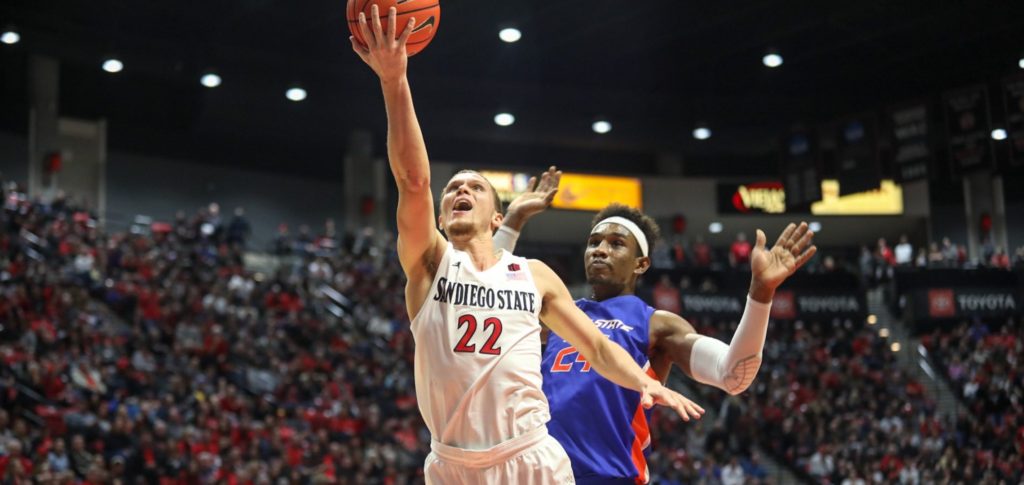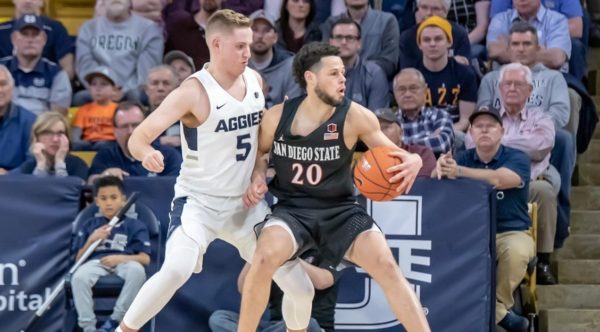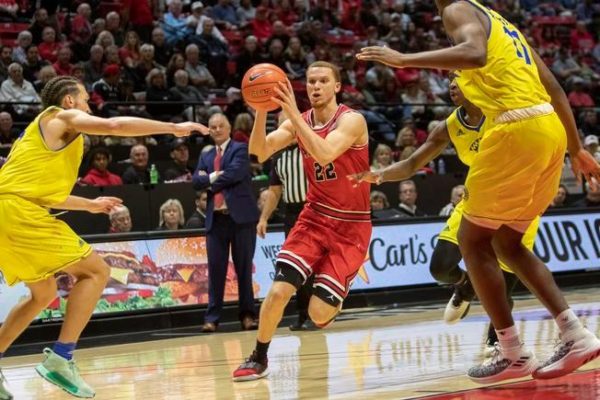What can the Aztecs improve upon before March?

Daily Aztec

From these responses, we can tell that there is a lot to like about this team, on both sides of the ball. There are some concerns, though, and the concerns I have mostly echo the concerns of my colleagues. I will try to expand on them a little bit.
There are a couple of things that worry me about this team. A couple are represented well by numbers, and a few aren’t.
My biggest concern is rebounding. Nathan Mensah was a presence on both the offensive and defensive boards. The biggest issue is on the defensive end, as Nathan Mensah was great at either getting the board or boxing out his man to let a teammate get the board. SDSU fans are well aware that the board man gets paid, but at the moment, the board man is on the bench with what the SDUT reported was a pulmonary embolism, likely until next season (he may return for the postseason). The defense has been surprisingly still very efficient without Nathan, but you need to end a defensive possession with a rebound for it to matter.
Luckily, fixing this problem is relatively easy. When watching the film, I notice many Aztec players will watch the ball as it’s coming off the rim, rather than locating their man and boxing out. This allows opposing players to slither into the lane and get a put-back opportunity. What the coaches can do is track how many times a player boxes out their man, and show it to the players in the film room. This is something I’ve heard of many other programs do in the past, and the success rate is pretty high with it. Tracking things like boxouts shows that it is important, and players will start to take pride in it. With more players boxing out when they need to, the defense will be even better as teams won’t get those easy points off of put-backs. For what it’s worth, I thought they started to show improvement against Utah State as they collected more rebounds and had a better rebounding rate than the Aggies.
Another thing I’m worried about is free throws on both sides of the ball. I’m not concerned about this team making their free throw attempts, because as a team, they hit over 75% of them, which is good. The national average is 70.5%. What concerns me is the rate at which this team gets to the line and the rate at which their opponents get to the line.
The Aztecs rank 274th in the nation at free throw attempt rate. That is well below average. Drawing fouls gives a team a couple of benefits. First, free throws are among the easiest and most efficient shots in the game, and the more fouls you draw, the more free throws you will get, leading to scoring more. It also gives the benefit of limiting the playing time of another team’s players, as they are forced to sit as they commit too many fouls. The Aztecs aren’t taking advantage of this as well as I’d like.
Over the past couple of years, teams that got far in the playoffs weren’t very good at drawing fouls either. Last year Virginia ranked 279th in drawing fouls. The year before that, Villanova ranked 287th; the list extends to the final four teams as well. So while it may be something I’d like to see, in recent history, it hasn’t seemed to matter much.
On defense, they rank 190th in committing fouls. Virginia last year ranked 21st. Villanova ranked 32nd. It is more problematic, as the benefits I described earlier are now going to the other team. We’ve seen a few games where the Aztecs struggle for a half in part because players like Malachi Flynn, Matt Mitchell, Yanni Wetzell, or some combination thereof, are sitting on the bench with foul trouble. Games like Iowa and at UNLV come to mind. The Aztecs managed to win those games, but it’s not something you want to risk in a single-elimination tournament.

The good news is when this team is locked in, you will see them play for 6-8 minutes straight without committing a foul, so the potential is there. They just need to learn to do that more consistently. Also, this issue has been slowly improving over the conference season. Their rate of committing fouls in the conference season would rank 120th in the nation, which still isn’t at the level of past champions and final four teams, but is showing improvement, and hopefully will continue to improve.
The last thing I wanted to point out is that this team seems to struggle at times against certain defenses. This is especially true when a team switches the defense they’re playing partway through the game. I believe this is what leads to the poor shot selection that Dominic brought up. The Aztecs take too long to figure it out and try to run an offense that won’t work well against the new defense. We see this a lot when a team switches to a 2-3 defense. The Aztecs will still run their mover blocker schemes to try to get a 3 point shot and break the zone. It can often take them 4 or 5 plays before they start running their zone offense. The issue gets compounded if they miss a couple 3 point shots because the opposing team is counting on those misses and gets a couple of minutes to catch up or possibly extend a lead. This Aztecs team is smart enough that once they start running the proper offense, they start scoring again. I would like to see that switch happen faster.
There are a couple of other little things that could use some polish, such as defensive communication. You wouldn’t think that would be an issue on a team ranked 8th in the nation in defensive efficiency according to KenPom, but you’ll see a few times a game someone will miss their assignment, often on switches, and the other team will score. Making sure everyone is communicating will help that.
Overall, this team is very good. An argument can be made that this is the best Aztec team in program history. They definitely have the potential to make it farther in the tournament than any other Aztec team has before, but it would help if they can improve in the areas that have been mentioned.
Native San Diegan living in Montana. Big time Aztec Basketball fan. Creator of Aztec Breakdown. Hoping to help people enjoy basketball more by increasing their understanding of it.